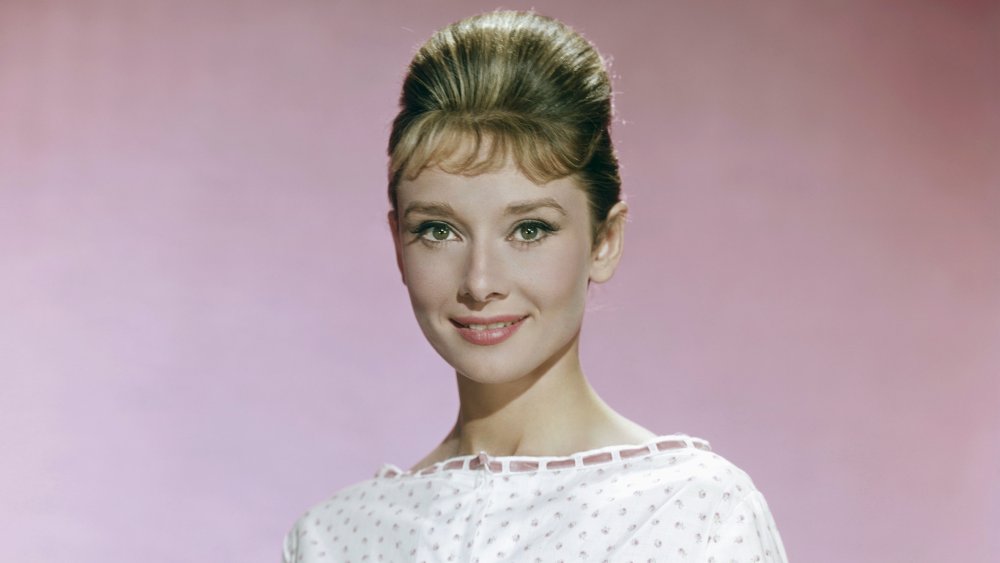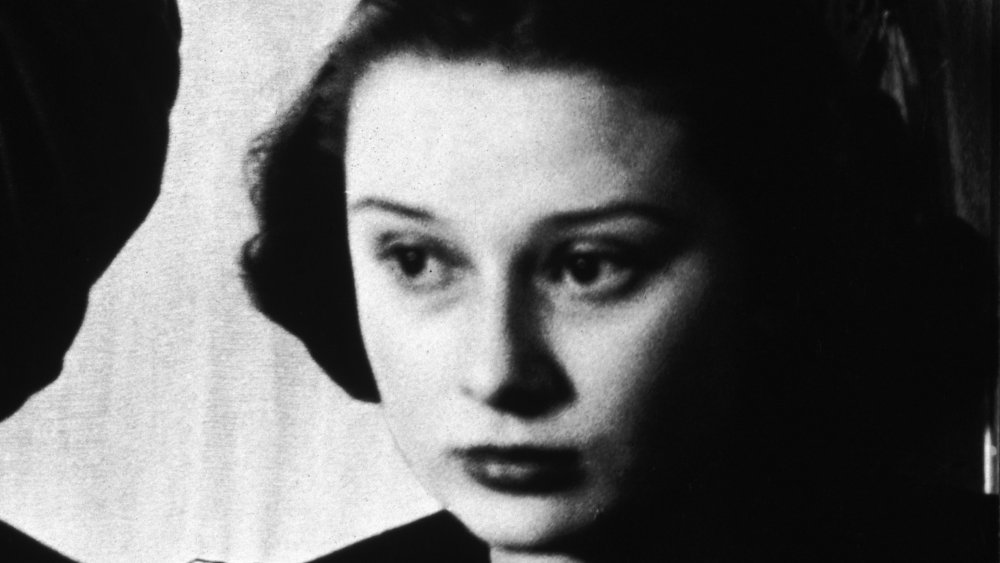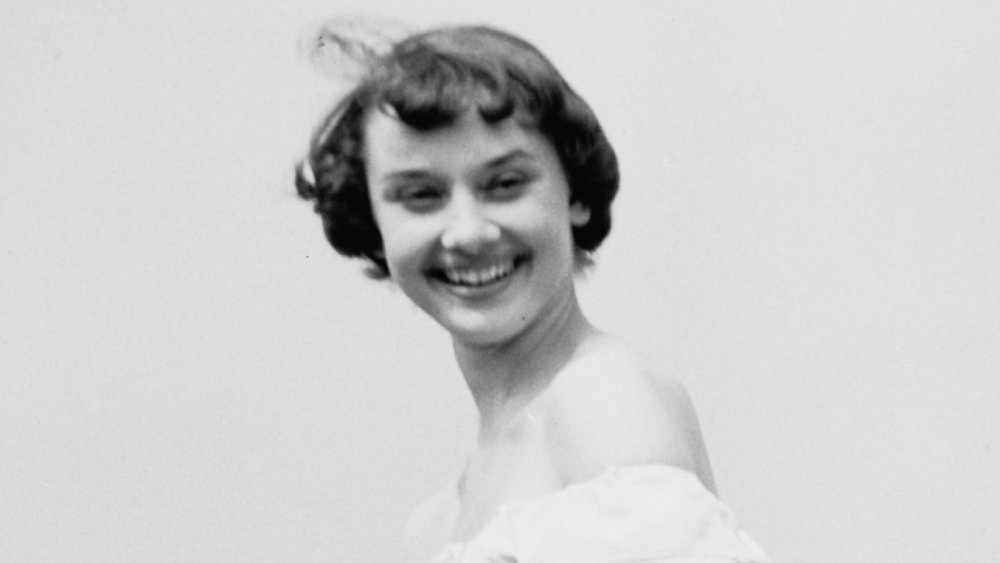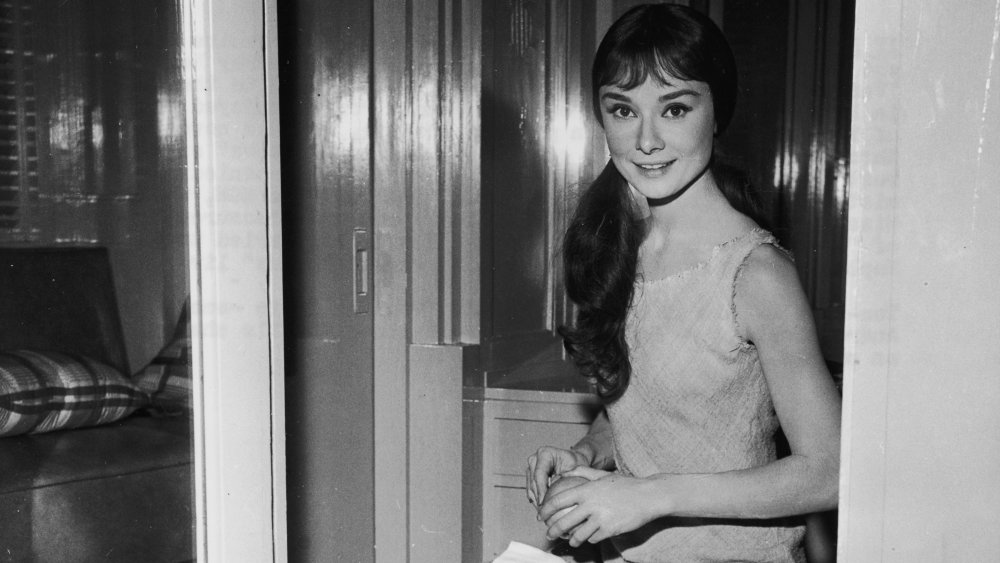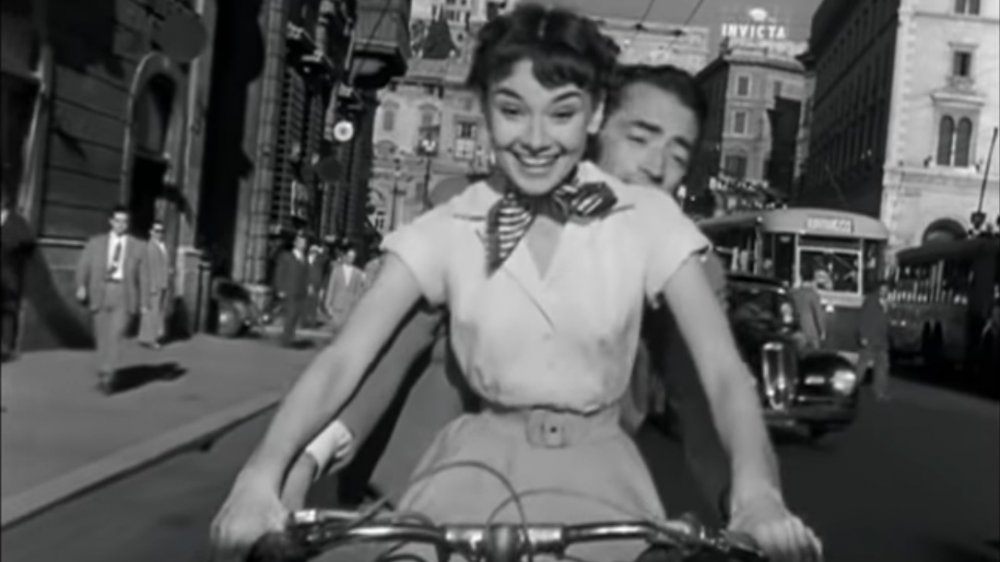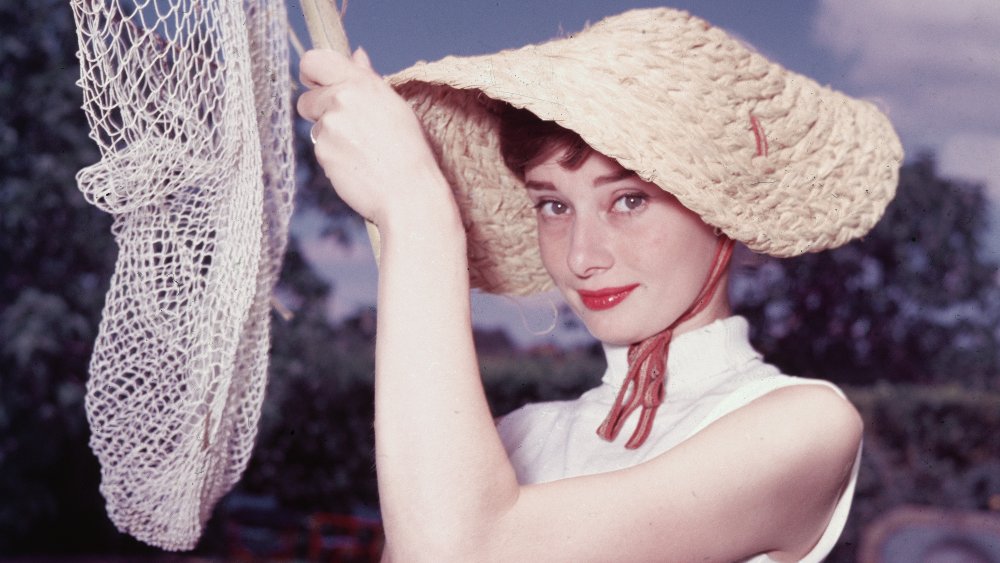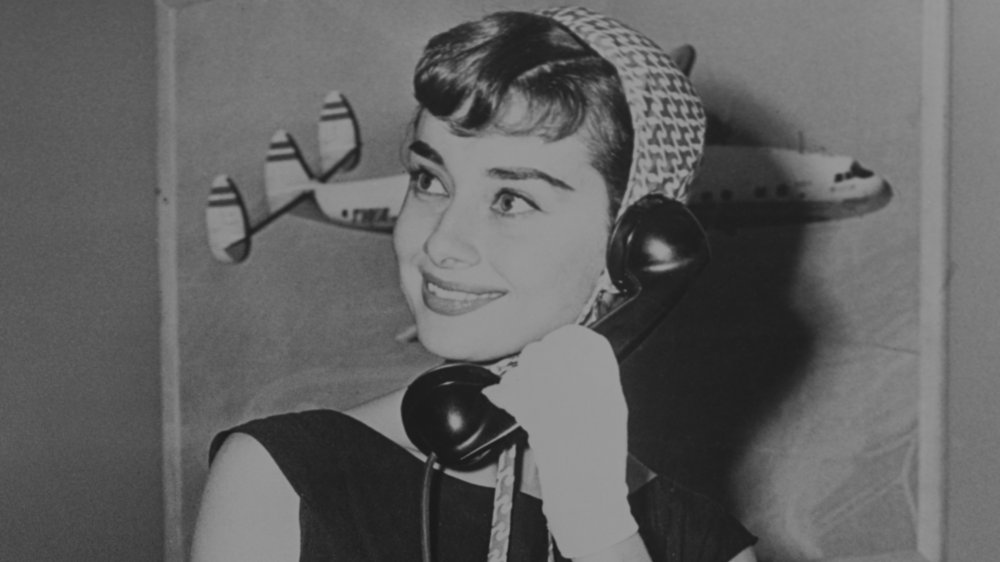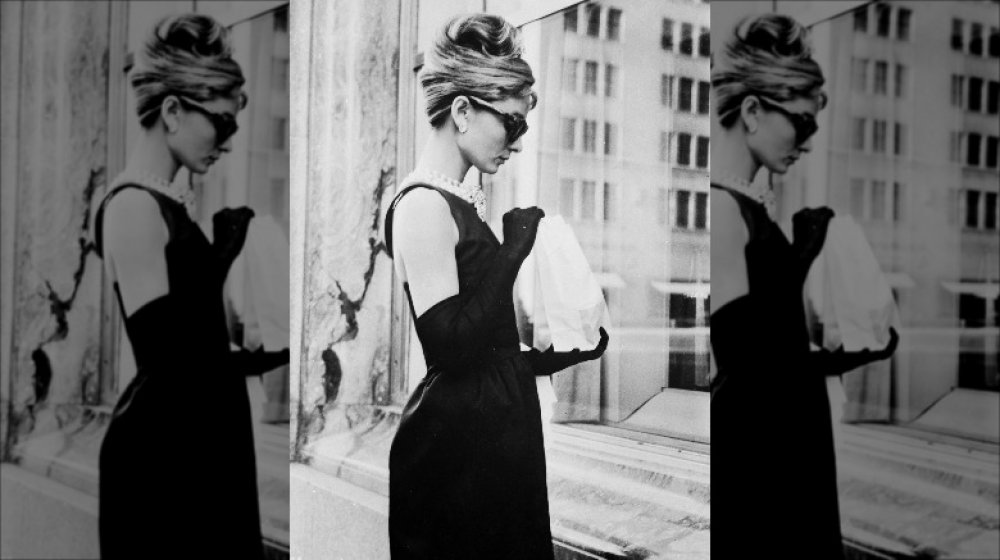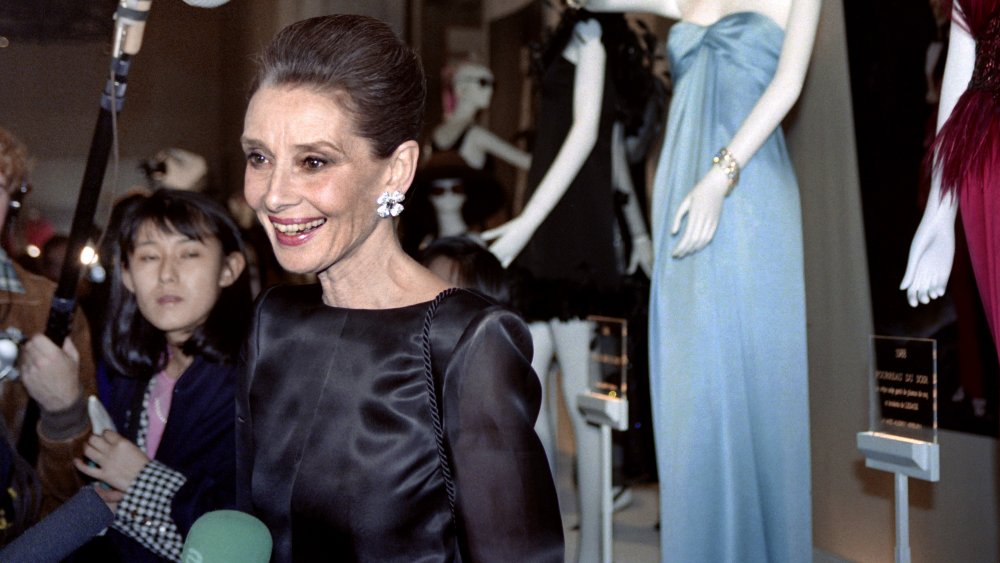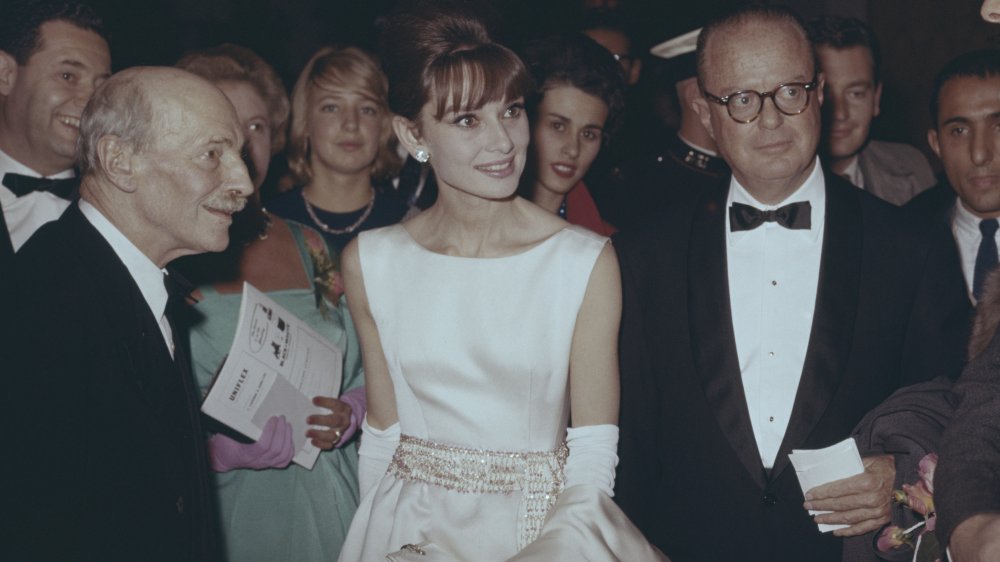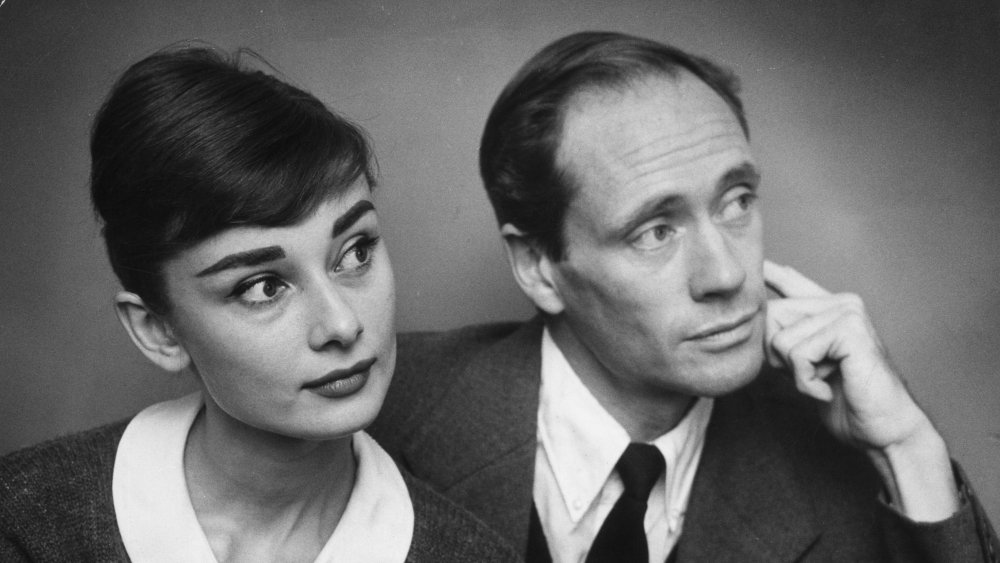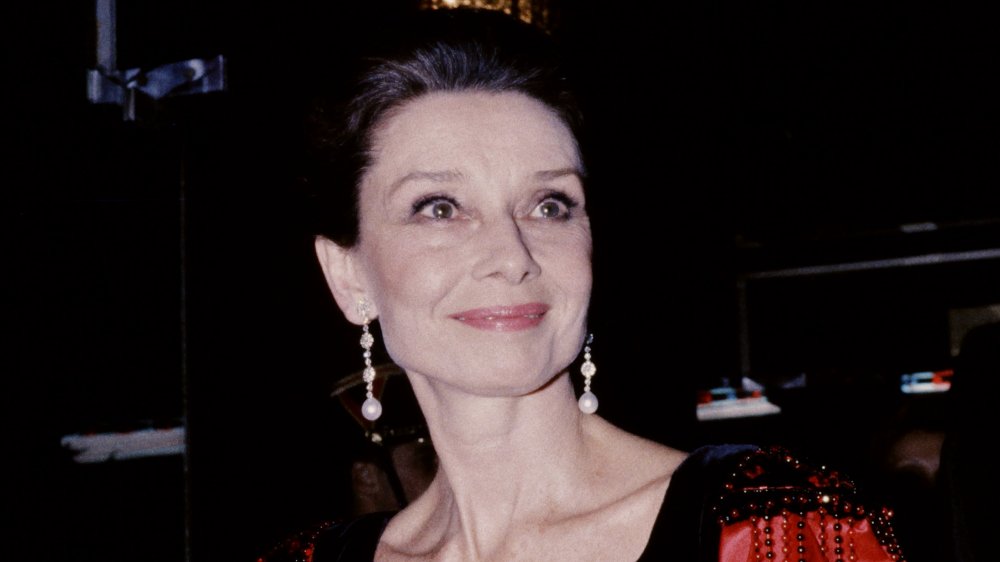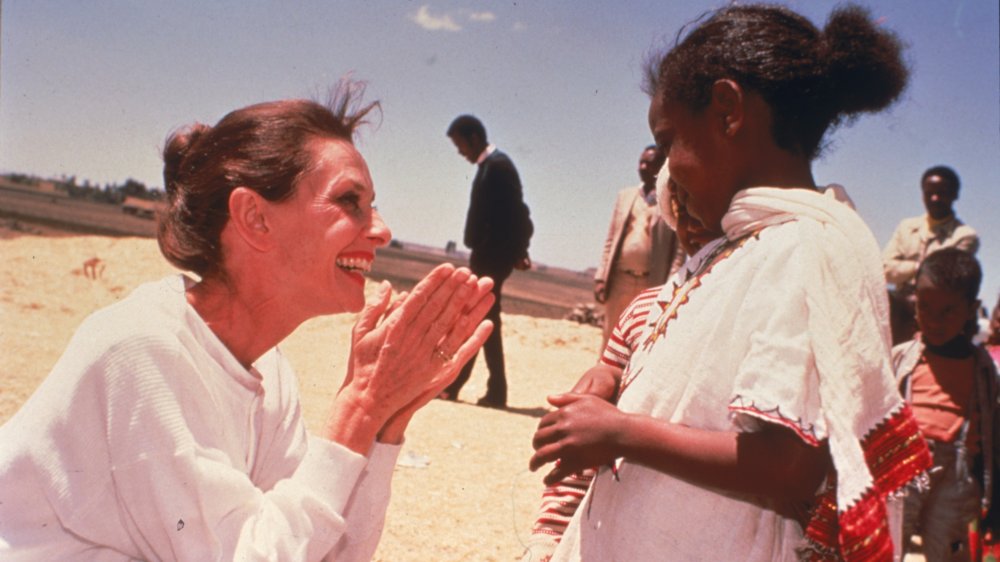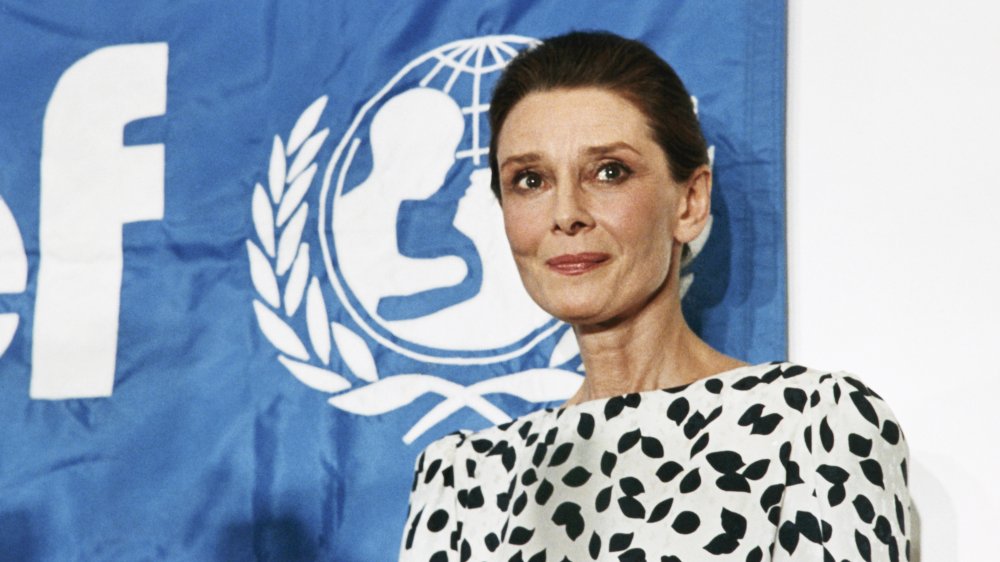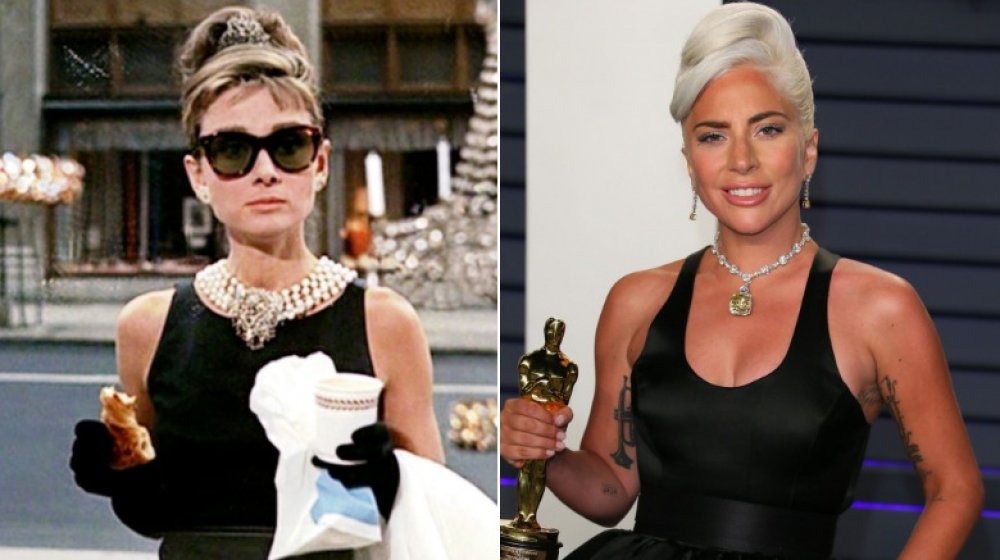The Untold Truth Of Audrey Hepburn
Audrey Hepburn's Hollywood career spanned nearly five decades and included some of the most beloved films of all time. Born in 1929 in Belgium, Hepburn rocketed to stardom when she was cast opposite Gregory Peck in the classic Roman Holiday, going on to even bigger success in such films as Breakfast at Tiffany's, Sabrina, and My Fair Lady.
While it's her film roles that are most remembered, the things Hepburn did both before and after her movie career are arguably even more fascinating than what she's known for onscreen. When movie roles grew scarce as she approached her 60s, Hepburn could have easily retreated to a life of luxurious retirement. Instead, she devoted her remaining years to helping others by bringing her celebrity to UNICEF through her role as a goodwill ambassador.
Decades after her death, Audrey Hepburn remains a Hollywood legend and one of the 20th century's most recognizable celebrities, yet there's a lot that even her most devoted fans may not know about this intriguing actress, style icon, and humanitarian. Read on to discover the untold truth of Audrey Hepburn.
Audrey Hepburn fought the Nazis as a member of the Dutch resistance
Growing up in the Netherlands during Nazi occupation proved to be a defining time in the life of Audrey Hepburn, and Robert Matzen wrote an entire book about it: Dutch Girl: Audrey Hepburn and World War II.
"The war made my mother who she was," Hepburn's son Luca Dotti, told Matzen, who chronicled her little-known role in the Dutch resistance while she was also studying ballet as a teenager. In a 2019 article for Time, Matzen quoted Hepburn describing how she danced in "underground concerts to raise money for the Dutch resistance movement. ... The recitals were given in houses with windows and doors closed, and no one knew they were going on. Afterwards, money was collected and given to the Dutch Underground."
Matzen also wrote of 15-year-old Hepburn smuggling food to an Allied fighter pilot whose plane had crashed. She was able to avoid detection because the German police considered her to be "safe." The author also offered a quote from Hepburn about her wartime efforts, who humbly downplayed her role. "Every loyal Dutch schoolgirl and boy did their little bit to help," she is quoted as saying. "Many were much more courageous than I was."
Audrey Hepburn spread messages of peace and survival during the Holocaust
As author Robert Matzen wrote in his book Dutch Girl: Audrey Hepburn and World War II (via Together), Audrey Hepburn was brought into the Dutch resistance by Dr. Hendrik Visser 't Hooft after she and her family moved from the city of Arnhen to the nearby town of Velp. The doctor, Matzen told the Times of Israel, "was instrumental. He knew where all the Jews were in Velp."
According to Matzen, Dr. Visser 't Hooft enlisted the teenage Hepburn to assist the resistance as "one of the ones [bringing] messages to families protecting Jews. She danced [to raise money] for the resistance, money to feed Jews in hiding. Nobody [wrote about] how enmeshed in the Jewish story she was."
Growing up during such a dark period in history undoubtedly affected Hepburn, yet miraculously it did not seem to imprint darkness on her psyche. As Matzen theorized, it somehow appeared to have the opposite effect. As he told the Times of Israel, "Here is a woman who, as a girl, experienced horrible things, and channeled them into beauty and positivity, spreading messages of peace and survival."
Audrey Hepburn had a complicated relationship with food
Prior to her death in 1993, Audrey Hepburn gave extensive interviews to biographer Diana Maychick, whose 1993 biography, Audrey Hepburn: An Intimate Portrait, was published posthumously later that year. According to a review in the Chicago Tribune, Maychick ultimately came to believe that Hepburn's slim physique was the result of an eating disorder, with its roots dating back to her malnutrition and near-starvation while growing up in Nazi-occupied Holland during the Second World War.
According to Maychick, Hepburn's wartime hunger led her to eventually "resent" food and treat hunger like something to be controlled. "I decided to master food; I told myself I didn't need it," Hepburn told Maychick of growing up hungry during the war. "Of course, I took it to an extreme," Hepburn added. "I forced myself to eliminate the need for food."
After Hepburn had watched friends, neighbors, and even her beloved Uncle Otto arrested and then executed, wrote Maychick, she also experienced survivor's guilt that likely contributed to her complex feelings about food and decision to skip meals. "Why was I spared when so many others were not?" Hepburn said. "I asked myself over and over..."
This letter helped make Audrey Hepburn a star
By 1953, Audrey Hepburn had appeared in a few film and television productions but was far from a star. That changed later that year when she was cast opposite Gregory Peck in Roman Holiday, a massive hit that rocketed her to stardom. However, landing that crucial role may never have happened had it not been for a very important letter.
In the letter, which has since been archived by the British Film Institute, Roman Holiday director William Wyler — who was in Rome prepping the film he had yet to cast — writes to fellow director Thorald Dickinson, who had just directed Hepburn in his 1952 film Secret People. Wyler had been sent a screen test of Hepburn that Dickinson directed, and Wyler revealed that "a number of the producers at Paramount have expressed interest in casting her."
Rumor has it that the role of Roman Holiday's Princess Ann was originally intended for Elizabeth Taylor; when she was unavailable, Hepburn's screen test presented a new option. "I can't say at the moment whether or not we will use Miss Hepburn in Roman Holiday," Wyler wrote before casting Hepburn, describing her screen test as being "as good as any I've seen in a long time."
Audrey Hepburn had a simple beauty routine
In 2015, Audrey Hepburn's son, Luca Dotti, wrote a personal memoir about his mother, Audrey at Home: Memories of My Mother's Kitchen. Among the many details he divulged in the book are Hepburn's beauty secrets, which were excerpted for French Vogue. Her biggest beauty tip is also the most basic: remain hydrated, which will keep the skin regenerated and plump. "She insisted so much on everybody ... drinking a lot of water. And that really, today, is so important for the support of everything," said Dotti, as reported by Yahoo! Lifestyle.
According to Dotti, Hepburn also had a love of potatoes, which he described as "her bread and butter." In addition, Dotti also revealed Hepburn was something of a vegetarian. "She ate meat, but very little, in little doses," he pointed out.
Dotti also explained that as his mother grew older, desperately battling to stay youthful was really not her thing. In fact, he wrote, Hepburn accepted aging gracefully. "She wasn't afraid at all of getting old. Of course she was complaining about the wrinkles, the white hair, but she really enjoyed her older years," said Dotti.
Audrey Hepburn's son believes he quashed her film career
Audrey Hepburn was married twice, first to actor Mel Ferrer (they divorced in 1968 after 14 years of marriage) and then, in 1969, to Italian psychiatrist Andrea Dotti (that marriage ended in divorce in 1982). In 1960, at the height of her fame, Hepburn and her first husband welcomed son Sean Hepburn Ferrer.
In an interview with Film Talk, Hepburn's firstborn opened up about his mother's insistence on putting her career on hold after starring in the 1967 thriller Wait Until Dark so she could focus on motherhood full-time. Hepburn would not appear onscreen again until 1976, opposite Sean Connery in Robin and Marian. "I suppose you could blame me for ending my mother's career," Dotti admitted. "If she had kept on working, her success professionally would have continued at a high level for many years."
As Ferrer recalled, the family lived in "a farmhouse" in Switzerland — far removed from the trappings of Hollywood — during his childhood. "I didn't grow up the son of a movie star, I didn't grow up in Hollywood, not the place, not the state of mind," he explained.
Audrey Hepburn wasn't the first choice for Holly Golightly
For most people, the name Audrey Hepburn is pretty much synonymous with one film: Breakfast at Tiffany's. Hepburn's portrayal of Manhattan party girl Holly Golightly in the 1961 film adaptation Truman Capote's novel has become so identified with her that's it's difficult to imagine anybody else in the role.
However, Hepburn was not the first actress under consideration for the part. As Vogue recalled, Capote was actually pushing for the studio to cast Marilyn Monroe. Monroe had even been offered the part, but turned it down on the advice of her acting teacher, Paula Strasberg, who haughtily suggested, "Marilyn Monroe will not play a lady of the evening."
Capote was reportedly livid over Hepburn's casting. "Paramount double-crossed me in every way and cast Audrey," the author said, as quoted by Vogue. "It was the most miscast film I've ever seen." Capote wasn't the only one who thought Hepburn wasn't fit to play Holly. Hepburn admitted that she herself "didn't think I was right for it." It wasn't until director Blake Edwards convinced her she could do it that she finally relented and took what would become her signature role.
Audrey Hepburn had a lifelong loyalty to Givenchy
Audrey Hepburn was more than just a movie star — she was also a fashion icon with a renowned sense of style and passion for haute couture. Throughout the bulk of her career, Hepburn stayed loyal to one fashion house: Givenchy. A 2014 article in Vanity Fair detailed the lifelong friendship that developed between Hepburn and fashion designer Hubert de Givenchy, who was hired to create her wardrobe for the 1953 film Sabrina. Givenchy would design Hepburn's wardrobe for her next seven films, as well as the clothing she wore in her personal life.
As Givenchy told Vanity Fair, it was when Hepburn modeled a tailored grey suit he had designed that he witnessed something extraordinary take place, a physical transformation as actress and fabric combined into something that transcended both. "She gave a life to the clothes — she had a way of installing herself in them that I have seen in no one else since ..." said Givenchy. "The suit just adapted to her. Something magic happened." Givenchy went on to dress Hepburn until her final days, and shared a fascinating tidbit: "Ever since Sabrina, Audrey kept exactly the same measurements."
This is how Audrey Hepburn came to be a fashion icon
When Sabrina hit theatres in early 1955, the marketing department at the film's studio, Paramount, came up with the idea of tying the Parisian fashions Audrey Hepburn wore throughout the film to the studio's promotional efforts. As Vanity Fair explained, this led to the film's premiere being held in Paris during Fashion Week. In addition, Paramount offered a special gift from the Paris boutique Prénatal to new mothers who named their baby daughters Sabrina, and even held a "Do you look like Sabrina?" contest.
As an end result of all this relentless promotion, designer Hubert de Givenchy became a major player in the Paris fashion world, the film became a box-office hit and women throughout the world strove to dress like Sabrina's fashionable star. Hepburn's innate sense of style became her hallmark, both on- and offscreen.
"Audrey's style is so strong," Givenchy told Vanity Fair. "Audrey's silhouette is so strong. It doesn't ever look passé. She is so present. It is difficult to think she is no longer with us — that I can no longer pick up the phone to call her. Her son Sean and I talk as if she is still alive."
Audrey Hepburn's husband grew to resent her success
Audrey Hepburn's first marriage to Cuban-born actor Mel Ferrer ended in divorce after 14 years. After his death in 2008, Express shed some light onto what went wrong. In fact, the publication paints a sad yet familiar tale of two Hollywood stars who fall in love and get married, only to have one's career eclipse the other's, leading to jealousy — and worse.
With his own career stalled, Ferrer became obsessively focused on his wife's. A quote from director King Vidor, who directed the couple in 1956's War and Peace, painted Ferrer as a Svengali. Vidor described Hepburn as "an innocent who doesn't know the business the way Mel does," while Ferrer "did all the talking for her." Vidor continued, "I believe he collects her salary personally."
The couple's son, Sean Hepburn Ferrer, was seven when his parents divorced. He told Express that while he never saw his parents argue — "they were very good about keeping any problems away from me," he stated — he was "quite aware from quite a young age that something just wasn't quite right, that something between them didn't quite jive."
Audrey Hepburn insisted on regular detox days
Audrey Hepburn was certainly forward-thinking when it came to what she ate, Hepburn's son, Luca Dotti, detailed in Audrey at Home: Memories of My Mother's Kitchen. One of the revelations Dotti shared, according to Yahoo! Lifestyle, was her habit of doing detoxes. In fact, she set aside one day per month as a "detox" day, eating nothing but fruits, vegetables, and yogurt and drinking plenty of water.
As Dotti explained, the practice evolved from his mother's extreme travel schedule, jetting from one part of the world to another. "She did it once a month, but usually to get over a jet lag, because you feel bloated after many hours sitting on a plane," said Dotti. "Like a lot of people, she was coming back from trips in Africa and was exhausted — this would help with that."
According to Hepburn's son, his mother's dietary tastes were simple. "[Her favorite meal was] pasta with tomato sauce. This was always everywhere, when she was coming home from a trip," he said.
This is why Audrey Hepburn became a UNICEF special ambassador
When her acting career waned as she approached her 60s, Audrey Hepburn used the power of her celebrity to help give voice to the voiceless. In the late 1980s, Hepburn was appointed as a UNICEF special ambassador and, later, she was also appointed as a goodwill ambassador. Her first mission was to Ethiopia, where drought and civil war had left the nation devastated.
When she returned she embarked on a media blitz, giving up to 15 interviews a day, with a goal of making the world aware of this humanitarian crisis. Subsequent trips included visits to Turkey, Venezuela, Ecuador, El Salvador, and many other countries. Her role with UNICEF also led her to testify before Congress, engage in the World Summit for Children, and participate in other initiatives.
In 1992, a year before her death, Hepburn was awarded the Presidential Medal of Freedom for her humanitarian efforts. "I can testify to what UNICEF means to children, because I was among those who received food and medical relief right after World War II," Hepburn said. "I have a long-lasting gratitude and trust for what UNICEF does."
Audrey Hepburn found her cancer diagnosis disappointing
In his 2003 biography of his mother, Audrey Hepburn, An Elegant Spirit: A Son Remembers, Sean Hepburn Ferrer revealed how Audrey Hepburn was in the midst of a UNICEF visit to Somalia when she was overcome with excruciating stomach pain.
As Ferrer told Film Talk, she was rushed back to California to see her doctor. The diagnosis was grim: a rare form of cancer, which had spread throughout her abdomen and was inoperable. When she learned the diagnosis, her son wrote, Hepburn looked wistfully out the window of her hospital room. "How disappointing," she said.
"The doctors gave her three months to live," Hepburn's longtime partner Robert Wolders told People. "She acknowledged being afraid of the pain but not being afraid of dying." According to Wolders, Hepburn wanted to spend her final days at her home in Switzerland, but her condition was so dire that commercial air travel wasn't an option. As a result, Hepburn's longtime friends Bunny Mellon and Hubert de Givenchy arranged for a private jet to bring her home. "She was basically on life support," said Wolders. Hepburn passed away in her Switzerland home on January 20, 1993.
There's a surprising connection between Lady Gaga and Audrey Hepburn
Lady Gaga made a huge splash at the 2019 Academy Awards, not just because she was nominated for two Oscars and performed a show-stopping duet with A Star is Born co-star Bradley Cooper, but also for being one of the best dressed stars in attendance.
In fact, Gaga showed up at the Oscars wearing a very special and very specific piece of jewelry: a 128.54-carat yellow diamond necklace, valued at £23 million (roughly $30 million). The necklace is best known for being worn by Audrey Hepburn in 1961's Breakfast at Tiffany's. While the design had been changed for a more updated look, Cosmopolitan reported that the 2019 Oscars marked the first time the diamond had been seen in public since the film — and the first time it had ever appeared on a red carpet.
"Lady Gaga is the ultimate creator, innovator and rule breaker, and I'm thrilled that she will be wearing the legendary Tiffany diamond on the awards show red carpet for the first time since it was discovered 141 years ago," Reed Krakoff, Tiffany & Co. chief artistic officer, told the publication ahead of the ceremony.
